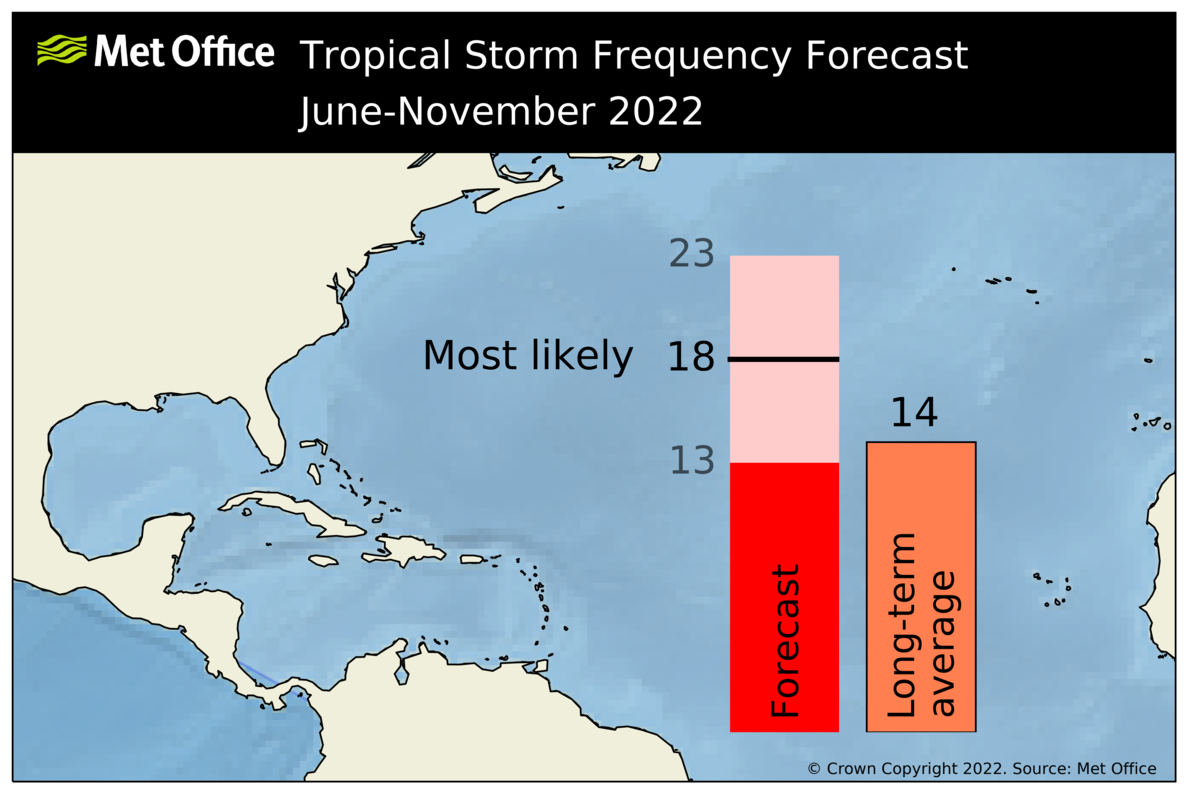The Atlantic hurricane season – which runs from June to November – is most likely to be above average for tropical cyclone activity according to the latest seasonal prediction from the Met Office.
The forecast for the coming season indicates a likelihood of 18 named tropical storms including nine hurricanes and four major hurricanes. The long-term annual average, between 1991-2020, is 14 tropical storms, seven hurricanes and three major hurricanes. A major hurricane is defined as a system with wind speeds of at least 111mph.
Julian Heming is the Met Office’s expert on tropical cyclones. Commenting on this year’s forecast he said: “What is interesting this year is that the forecasts issued by many different agencies are all indicating an above-average season. As they are all pointing in the same direction this gives us a higher degree of confidence.”

The forecast covers the whole of the North Atlantic Basin, including the North Atlantic Ocean, the Caribbean Sea and the Gulf of Mexico. Julian added: “Because our hurricane outlook covers a wide region, it isn’t possible to determine the exact track and locations of these tropical cyclones and therefore it isn’t possible to determine impacts either.
“What could happen is that the season is active, but the storms don’t necessarily make landfall. Conversely, another season may have lower cyclone activity overall, but just one or two major hurricanes making landfall can produce large impacts. However, there is a signal in our forecast for heightened activity this season to be biased towards the western side of the basin, including the Caribbean, Gulf of Mexico and the eastern seaboard of the United States.”
If the 2022 season sees above-average activity it would continue a series of active Atlantic hurricane seasons which has been ongoing since 2016. This period has seen a number of damaging hurricanes affecting the USA and the Caribbean including Hurricane Dorian in 2019, Hurricane Laura in 2020 and Hurricane Ida in 2021.
| Year | Tropical storms | Hurricanes | Major hurricanes |
| 2012 | 17 | 10 | 2 |
| 2013 | 13 | 2 | 0 |
| 2014 | 8 | 6 | 2 |
| 2015 | 10 | 4 | 2 |
| 2016 | 14 | 6 | 4 |
| 2017 | 16 | 10 | 6 |
| 2018 | 14 | 8 | 2 |
| 2019 | 17 | 6 | 3 |
| 2020 | 28 | 13 | 7 |
| 2021 | 20 | 7 | 4 |
Climate change
Tropical cyclones derive their energy from warm water, and sea surface temperatures above 26°C are necessary to sustain them. Tropical cyclones encountering cooler waters lose intensity. With climate change raising global temperature levels it could be expected to see an increase in the frequency and intensity of tropical cyclone activity.
However, as Julian notes: “We do expect to see an underlying trend from the impacts of global warming to produce slightly stronger tropical cyclones. But on a year-to-year basis any increase is masked by the large amounts of natural variability with some seasons containing far more activity than others.”
For more information about the North Atlantic 2022 tropical cyclone forecast, listen to Julian Heming in conversation with Clare Nasir on our Weather Snap podcast.


